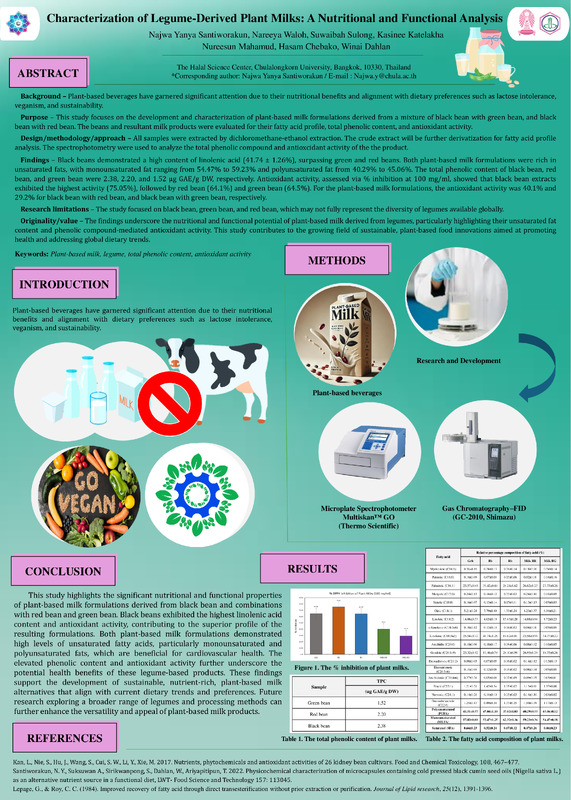-
Tittle
-
Characterization of Legume-Derived Plant Milks: A Nutritional and Functional Analysis
-
Conference Acronym
-
IHSATEC 2024: 17th JHASIB
-
DOI Number
-
https://doi.org/10.31098/HST24157
-
Conference Date
-
December 19-20, 2024
-
presented at
-
The International Halal Science and Technology Conference 2024 (IHSATEC): 17th Halal Science Industry and Business (HASIB)
-
Poster Author(S)
-
Najwa Yanya Santiworakun, Nareeya Waloh, Suwaibah Sulong, Kasinee Katelakha Nureesun Mahamud, Hasam Chebako, Winai Dahlan
The Halal Science Center, Chulalongkorn University, Bangkok, 10330, Thailand
-
Conference Theme
-
IHSATEC 2024: 17th HASIB
-
Abstract
-
Background – Plant-based beverages have garnered significant attention due to their nutritional benefits and alignment with dietary preferences such as lactose intolerance, veganism, and sustainability. Purpose – This study focuses on the development and characterization of plant-based milk formulations derived from a mixture of black bean with green bean, and black bean with red bean. The beans and resultant milk products were evaluated for their fatty acid profile, total phenolic content, and antioxidant activity. Design/methodology/approach – All samples were extracted by dichloromethane-ethanol extraction. The crude extract will be further derivatization for fatty acid profile analysis. The spectrophotometry were used to analyze the total phenolic compound and antioxcidant activity of the the product. Findings – Black beans demonstrated a high content of linolenic acid (41.74 ± 1.26%), surpassing green and red beans. Both plant-based milk formulations were rich in unsaturated fats, with monounsaturated fat ranging from 54.47% to 59.23% and polyunsaturated fat from 40.29% to 45.06%. The total phenolic content of black bean, red bean, and green bean were 2.38, 2.20, and 1.52 μg GAE/g DW, respectively. Antioxidant activity, assessed via % inhibition at 100 mg/ml, showed that black bean extracts exhibited the highest activity (75.05%), followed by red bean (64.1%) and green bean (64.5%). For the plant-based milk formulations, the antioxidant activity was 40.1% and 29.2% for black bean with red bean, and black bean with green bean, respectively. Research limitations – The study focused on black bean, green bean, and red bean, which may not fully represent the diversity of legumes available globally. Originality/value – The findings underscore the nutritional and functional potential of plant-based milk derived from legumes, particularly highlighting their unsaturated fat content and phenolic compound-mediated antioxidant activity. This study contributes to the growing field of sustainable, plant-based food innovations aimed at promoting health and addressing global dietary trends.
Keywords: Plant-based milk, legume, total phenolic content, antioxidant activity
-
Publisher Name
-
Yayasan Sinergi Riset dan Edukasi
-
Publication Date Online
-
19-12-2024


